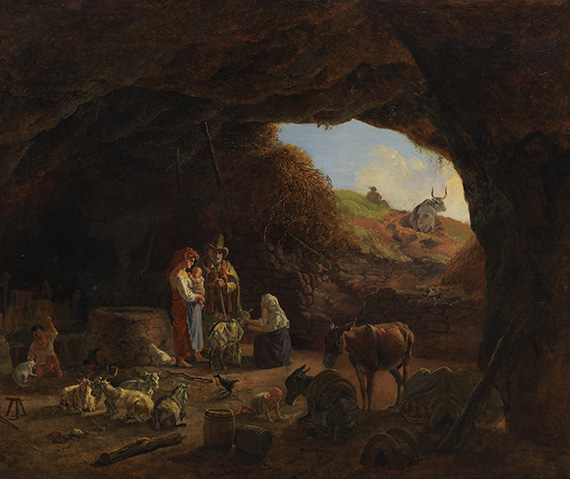322
Heinrich Bürkel
Italienische Hirtenfamilie in der Felsenhöhle, Um 1830/40.
Oil on canvas
Estimate:
€ 7,000 / $ 7,490 Sold:
€ 7,620 / $ 8,153 (incl. surcharge)
Italienische Hirtenfamilie in der Felsenhöhle. Um 1830/40.
Oil on canvas.
Lower left monogrammed. With several estate stamps and the hand-written number "492" on the reverse. 39 x 46.5 cm (15.3 x 18.3 in).
PROVENANCE: Private collection Bavaria (family-owned for two generations).
LITERATURE: Hans-Peter Bühler, Albrecht Krückl, Heinrich Bürkel mit Werkverzeichnis der Gemälde. Munich 1989, no. 508 (fig.).
Münchner Kunstversteigerungshaus Adolf Weinmüller, Munich, auction on December 14, 1948, lot 527 (fig.).
Auktionshaus Neumeister vorm. Weinmüller, Munich, auction on May 12, 1976, lot 1556 (fig.).
Oil on canvas.
Lower left monogrammed. With several estate stamps and the hand-written number "492" on the reverse. 39 x 46.5 cm (15.3 x 18.3 in).
PROVENANCE: Private collection Bavaria (family-owned for two generations).
LITERATURE: Hans-Peter Bühler, Albrecht Krückl, Heinrich Bürkel mit Werkverzeichnis der Gemälde. Munich 1989, no. 508 (fig.).
Münchner Kunstversteigerungshaus Adolf Weinmüller, Munich, auction on December 14, 1948, lot 527 (fig.).
Auktionshaus Neumeister vorm. Weinmüller, Munich, auction on May 12, 1976, lot 1556 (fig.).
Heinrich Bürkel's painterly expression was trained by his self-taught study of the paintings of the Dutch masters Wouwermans, Wijnants and van de Velde in the Schleißheim Picture Gallery near Munich. He adopted their fine painterly precision, coupled with a fidelity to reality. The so-called Bambocciades, a type of Dutch/Italian genre painting in 17th-century Rome, attracted his painterly attention in particular. The small scenes address simple folk life, inhabited by shepherds, brigands, country dwellers, in all forms of human coexistence, whether of positive or negative nature, sometimes also involved in brawls. Bürkel himself traveled to Italy a total of four times (in 1827, 1830, 1837 and 1853), sometimes spending up to two years there. Evidence of these stays can be found in paintings such as “View of Rome with the Baths of Caracalla in the foreground”, 1829 (National Gallery, London), but also in works such as "Trattoria in front of the Porta San Sebastiano near Rome", around 1830/1832, "Sheep Shearing in the Campagna", around 1850, or "Italian Brigands", around 1830/1832, all in the Bavarian State Painting Collections, Neue Pinakothek, Munich. These early Italian-influenced landscapes clearly stand out from the heroically idealized landscape painting by Reinhart or Koch, and show Bürkel's true affiliation to the genre. He seems to have been particularly fascinated by the numerous caves in the Roman Campagna, which served as accommodation for shepherds, brigands and itinerant folk and shaped his Italian landscape motif repertoire. In 1834, King Ludwig I became aware of him and bought a small painting from the Munich Kunstverein. This marked the social breakthrough of the self-taught and non-academic Bürkel. Bürkel's most popular motifs in the Alpine region, the mountain village with fountain or the brawl in front of the inn, are among the most frequently repeated motifs, while the earlier views of Italy are less common. In the following years, he found numerous buyers among European princes as well as buyers in North America and was considered one of the most popular landscape and genre painters of the Munich School. [KT]
322
Heinrich Bürkel
Italienische Hirtenfamilie in der Felsenhöhle, Um 1830/40.
Oil on canvas
Estimate:
€ 7,000 / $ 7,490 Sold:
€ 7,620 / $ 8,153 (incl. surcharge)




 Lot 322
Lot 322 
